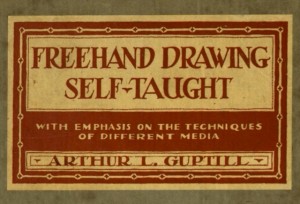Guptill, Arthur L. Freehand Drawing Self-Taught with Emphasis on the Techniques of Different Media. New York: Harper & Brothers, 1933.
Our copy of this work belonged to Professor Owen Cappleman, who was a faculty member of the School of Architecture. On the first few pages are a series of sketches- two of faces and one of a drum, I think. It was the sketches that piqued my interest!
I cannot draw. It was not a skill I pursued but often think I should, especially when I am trying to sketch something into my field notes and end up relying on my camera. In his introductory essay, “Some Preliminary Considerations: Encouragement and Advice for the Beginner,” Arthur Guptil writes:
Drawing is, in our early youth- and should be throughout life- a far more natural means of expression than writing. For writing, like talking, must be learned. Drawing, of course, needs study, too, before one can go far with it. Yet what child does not draw well, relatively speaking, without the slightest tutoring? Give him chalk and a sidewalk, a stick and a beach of sand, or pencil and paper, and he produces results which, all things considered, are little short of marvelous. (pg. 1)
I rather like his perspective. Despite my inability to draw well, I often find that a quick sketch is far easier than words in certain situations.
Guptill illustrates the first half of the work with his own sketches and drawings “to illustrate points brought out by the text” (pg. vii). While he does showcase a variety of techniques like outlining and shading, his own style and choice of subject matter feels very 1930s to me, which makes the book interesting to look through even if one does not intend to learn to draw.

